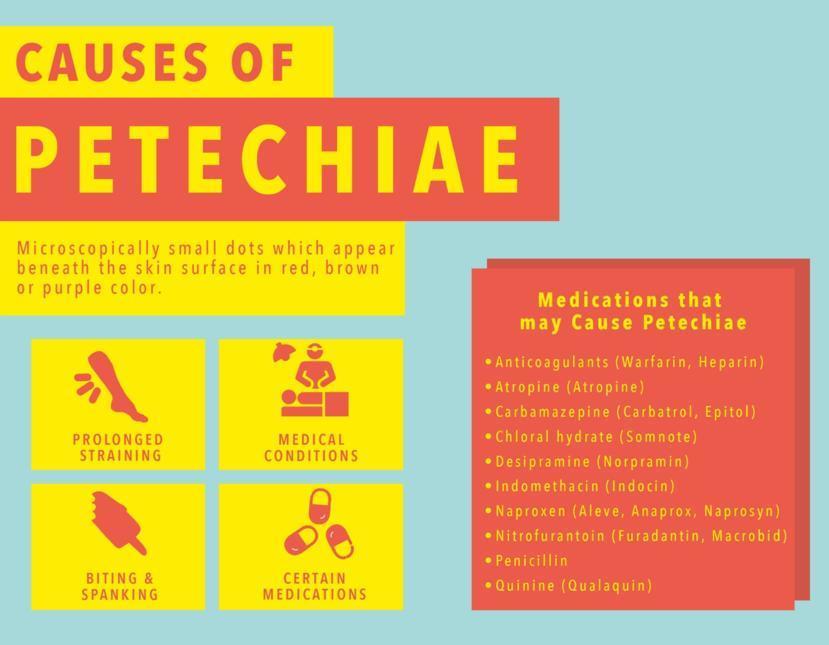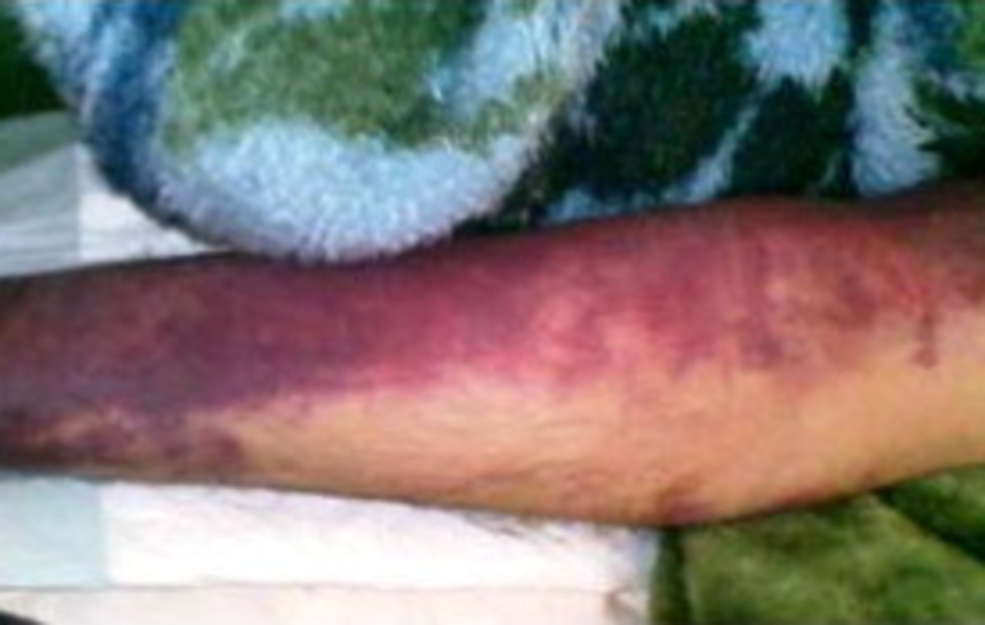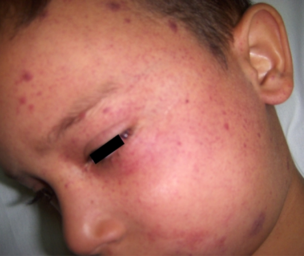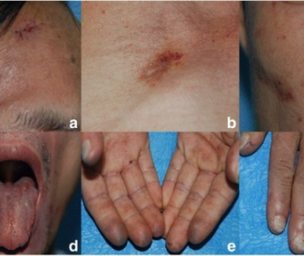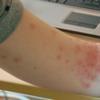What Are Petechiae?
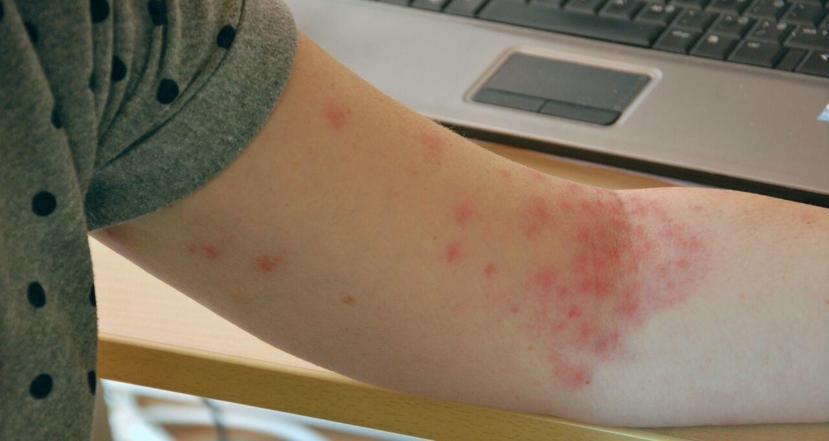
What Are Petechiae?
Petechiae can be described as marks or blotches that normally appear on the skin and are tiny, round, and purplish or reddish in color. Petechiae are usually pinpoint-sized. Minor hemorrhage (bleeding that is localized below the skin) is the source of petechiae.
Although they mostly appear in clusters, petechiae may also look like a rash. Usually, petechiae spots appear on the legs although they may also spread or appear on other body parts. They are mostly harmless and do not need any treatment and heal on their own in a few days. In some cases, however, petechiae may not heal naturally and may have other symptoms that require medical attention.
Petechiae causes
Petechiae are surprisingly fairly common to all people. As they come as a sign of any of several conditions, it is important that you contact your physician so as to determine the possible cause. Your physician will help you understand whether it is something serious or minor.
Some of the possible causes that are linked to petechiae are as follows:
• Thrombocytopenia: Petechiae that normally show on the lower legs are a symptom of thrombocytopenia. Thrombocytopenia is a disorder that is normally characterized by unusual low levels of platelets. Also known as thrombocytes, platelets are colorless blood cells that assist with the clotting of blood. Thrombocytopenia can come as a result of a disorder of the immune system, a serious condition like leukemia, or side effects of particular medications.
• Continuous straining: Petechiae that may appear on your face, neck, and chest are mostly a result of prolonged straining like childbirth or the lifting of heavy weights. These petechiae may also appear due to consistent vomiting, choking, continuous crying, or violent coughing.
• Certain medicines: Petechiae on the skin may occur as a result of a reaction to some medicines such as chloral hydrate, aspirin, cortisone, atropine, naproxen, indomethacin, carbamazepine, carbamazepine, penicillin, phenytoin, cimetidine, Rifampin, and linezolid. Petechiae may also be caused by anticoagulants like heparin or warfarin.
• Sunburns or injuries: The occurrence of petechiae in the face and eyes may be influenced by some traumas or injuries. Strangulation or smothering, for example, may result in petechiae. Petechiae may also be caused by biting, spanking, or being involved in a car crash. Severe burns may sometimes influence petechiae.
• Sepsis: Severe sepsis as a result of low platelet levels may result in petechiae. Sepsis is a fatal disorder that results from an infection. Sepsis develops when there is a release of chemicals into the bloodstream so as to battle an infection, which in turn causes inflammation all over the body. Sometimes, sepsis may result in septic shock, which is a drop in blood pressure and may lead to death.
• Hypersensitivity: Petechiae may be a symptom of a hypersensitivity (allergic reaction) like allergic purpura. This is a hemorrhagic condition whereby internal bleeding beneath the skin can result in spontaneous bruising and petechiae.
• Autoimmune disorders: Some autoimmune conditions such as lupus and rheumatoid arthritis are associated with petechiae. Rheumatoid arthritis is described as an autoimmune reaction whereby the cartilage in the joints is attacked by white blood cells. Due to this, rashes, inflammation, and also petechiae may develop on the affected parts. Petechiae may also be linked to discoid lupus erythematosus and systemic lupus erythematosus.
• Malnutrition: One of the most common sources of petechiae is malnutrition. Petechiae are associated with nutritional deficiencies of B vitamins such as folate, B9 and B12, and Vitamin K and Vitamin C.
• Strep throat: Strep throat is a bacterial throat condition that results from streptococcus pyogenes. With this condition, petechiae appear on the back of the mouth’s roof. Some of the other symptoms that are linked with strep throat are a swollen or dry throat, engorged lymph nodes in your neck, and also throat pain resulting from talking, swallowing, or breathing.
• Scarlet fever: This is described as a bacterial infection that may sometimes occur in strep throat patients. Petechiae linked with this condition appear like a bright red rash that normally spreads all over the body. This rash will look like sunburn or feel like sandpaper. Other scarlet fever symptoms are sore throat, high fever, a flushed face, and a strawberry tongue.
Other causes
There are other possible causes of petechiae, and they include cytomegalovirus infection, endocarditis, Hantavirus pulmonary syndrome, viral hemorrhagic fevers, Rocky Mountain spotted fever, meningococcemia, and mononucleosis. Petechiae may also result from idiopathic thrombocytopenic purpura, vasculitis, chemotherapy and radiation, Von Willebrand disease, and viral infections that normally impair the clotting of blood.
Symptoms that may accompany petechiae
The symptoms that may accompany petechiae vary with the underlying condition. Flu-like symptoms, malaise, and fever accompany infectious conditions. There are also other symptoms of the particular system that is affected by the infection. Initially, petechiae are red in color and appear like individual blotches. After some time, they come together and look like a rash. Petechiae are normally flat spots that alter their color as time goes on. If you or a member of your family develop petechiae, it is important that you promptly seek medical attention. Establishing the potential cause is important, since some causes can be fatal.
Differential Diagnosis of Petechiae
Petechiae diagnosis begins with the history of the patient and their physical examination. There are blood tests that are conducted, including the following:
• Bleeding time
• CBC (complete blood count)
• Partial thromboplastin time
• Platelet count
• Prothrombin time
It is important to conduct these tests since they differentiate petechiae from other conditions like the following:
• Purpura
• Hypersensitivity angiitis
• Scurvy
• Thrombocytopenia
• Rickettsial spots
• Wiskott-Aldrich syndrome
The difference between Petechiae and Purpura
Differentiating between purpura and petechiae can sometimes be difficult. Petechiae spots have a tiny diameter of 3 mm, while purpura rashes are larger in size (having a diameter of 5 mm). If a spot is larger than purpura, it is mostly known as Ecchymosis or a bruise.
Characteristics of petechiae
Petechiae have certain features that are specific only to them, and this helps in detecting them early and in differentiating them from other spots and rashes.
• Petechiae size - The size of petechiae is 3 mm maximum. They are very small hemorrhagic spots and are normally 0.5-1 mm in diameter. A bigger form of petechiae that measures more than 3 mm is known as purpura.
• Petechiae location - Although petechiae can appear on any part of the body, they mostly appear on the ankles, face, legs, shoulders, back, and thighs.
• Petechiae color - The first color of petechiae is normally red and looks like a rash. It later turns purplish or bluish. At last, the color turns blue or dark purple.
• Failure to fade under pressure - One of the main characteristic features of petechiae is that they never fade when pressure is applied on them.
Treatment of petechiae
Usually, petechiae are cured by getting rid of the underlying illness that is causing the spots. This may be done by doing the following:
• Applying ice: In case the spots are caused by injuries to blood capillaries, they may be cured by applying ice packs on the affected part.
• Stopping medication: If the cause of the petechiae is an allergic reaction to a certain medicine, the easiest option is to stop using the medicine immediately.
• Antibiotics: If the petechiae are the result of an infectious condition, antibiotic medication may be recommended.
• Platelet transfusion: If petechiae on the legs are caused by low platelet count, the condition can be treated through platelet transfusion.
• Surgery: Surgery may be recommended in case the petechiae are brought about by a malignant illness such as leukemia or cancer.
Petechiae on legs
Petechiae on the legs are mostly caused by hemorrhage or bleeding. This is what gives them the brownish, reddish, or purple color. Whether they show on your legs or other parts of the body, petechiae will feel generally flat to the touch, and they do not fade in color when pressed. Sometimes, petechiae will appear in parts like the eyelids or mouth.
The spots of petechiae will be bigger if an individual had deeper bleeding beneath the skin, and these are known as bruises. You can differentiate petechiae from extreme major blood vessels by applying pressure on the spot. The color of the spot will temporarily disappear under pressure if the redness is as a result of a large blood vessel. If the spot is a petechia, the reddish color of the spot will not fade when pressed.
If petechiae occur during an illness, it will be a different case. In case the presence of bacteria is noticed in the blood vessels, more so meningococcus (bacteria causing spinal meningitis), the condition can occur as petechiae. It is important to visit your physician in such cases since this form of petechiae in an adult or child may indicate a very fatal sepsis case, even when the patient does not look like they are sick.
Causes of petechiae on legs
There are a number of causes of petechiae on the legs and they include allergy, trauma, hemorrhage and pressure.
- Petechiae on legs caused by injury or trauma
The primary source of petechiae on legs and other body parts is trauma. In case there is a lot of pressure or force being applied on the body tissue, this stress can result in the occurrence of petechiae spots. When the blood capillaries are injured, this may lead to hemorrhaging, which in turn results in the leakage of red blood cells from the capillaries and the subsequent accumulation of blood below the skin.
Blood accumulation below the skin following an injury can sometimes be greater, particularly if there is no opening below the skin’s surface for blood to come out.
- Petechiae on legs caused by medications
There are some medicines that lead to allergic reactions, which results in the development of petechiae in your skin. Side effects of some medicines like warfarin, aspirin, cortisone, and heparin may also lead to petechiae.
- Petechiae on legs caused by fever
You are more likely to have petechiae if you have fever. This is mostly caused by the presence of meningococcus bacterium in your blood.
- Petechiae on legs as a result of cancer
Leukemia and cancer of the bone marrow are life-threatening conditions that bring down the platelet count. This is termed as a big source of petechiae.
- Petechiae on legs due to cancer treatment
Petechiae may occur on the legs as a result of an adverse effect of radiation and chemotherapy for the treatment of cancer.
- Petechiae on the legs caused by thrombocytopenia
Thrombocytopenia is a condition that develops as a result of reduced platelet levels in your body and may lead to petechiae. This condition may also develop due to the side effects of medicine. This in turn impairs platelet functioning, resulting in the occurrence of petechiae.
Other petechiae causes on legs
Other potential sources for the occurrence of petechiae on legs are autoimmune conditions and viral infections.
Petechiae on legs symptoms
The initial color of a petechiae rash is red, and then it starts to gradually turn purple or blue. In the last stages, the spots of petechiae change to dark blue to dark purple. The spots' size is approximately 3mm even in the final stages.
Although petechiae may initially develop on the legs, they may spread to other body parts like the ankles, back, thigh, face, and shoulders. Petechiae on the face come mostly as a result of crying, vomiting, or coughing, and this result in the development of red spots on the face's skin.
The color of petechiae mostly turns to brown from red and later to purple. Due to blood oxidation, the spots may look brown or dark purple. The blotches develop individually in the first stages and as the spots continue to form, they begin to cluster.
Petechiae treatment on the legs
Petechiae treatment is normally aimed at getting rid of the main cause of the spots. The patient may require medical attention if the petechiae are a result of medication. The medicine should be stopped or changed if it is leading to allergic reactions.
If the cause of the petechiae is an infection, you may need to take antibiotics. If the cause of the petechiae is malignant conditions such as leukemia or cancer, surgery may be required. Platelet transfusion and ice use are other methods of treating petechiae.


